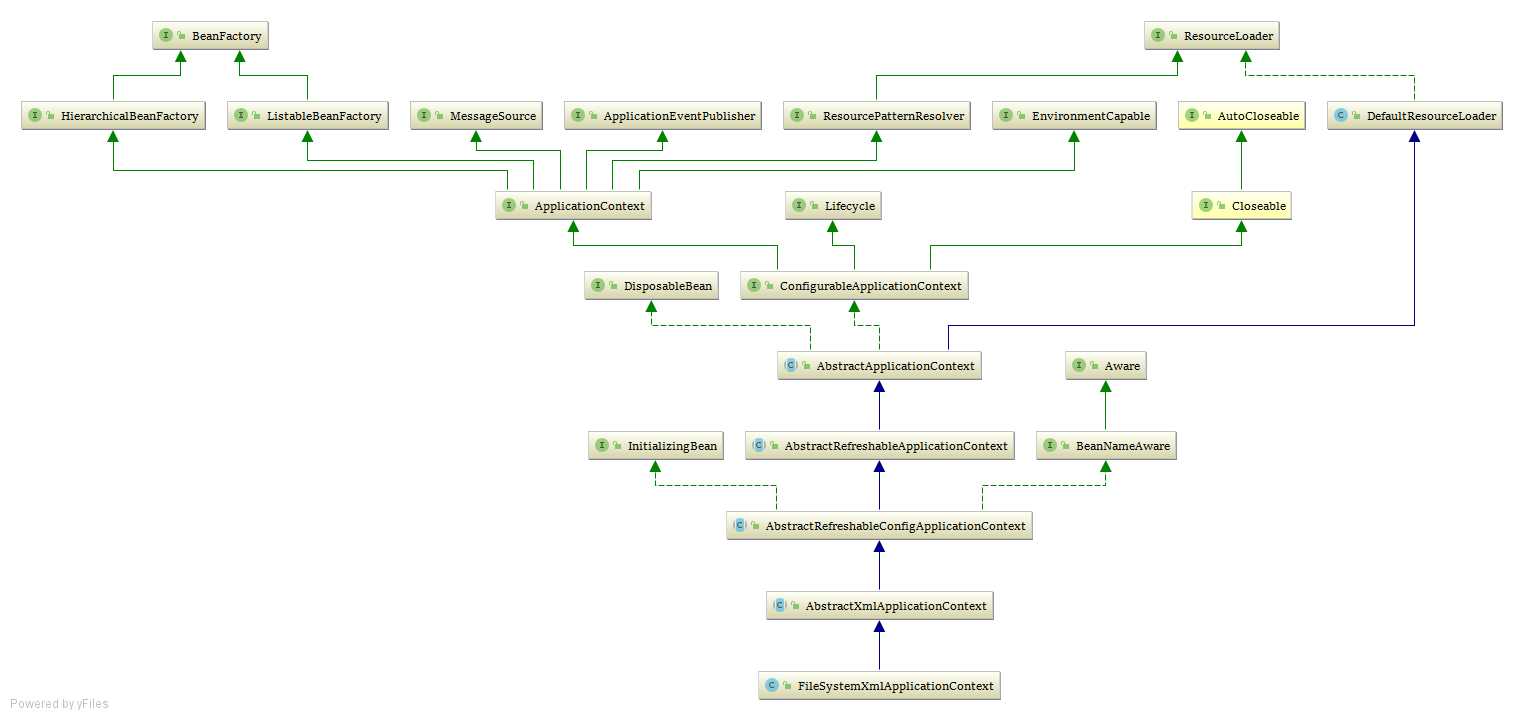spring源码解析之IOC容器(一)
2020-12-13 03:19
标签:one init Nid ble not must this bug substring 学习优秀框架的源码,是提升个人技术水平必不可少的一个环节。如果只是停留在知道怎么用,但是不懂其中的来龙去脉,在技术的道路上注定走不长远。最近,学习了一段时间的spring源码,现在整理出来,以便日后温故知新。 IOC容器是spring最核心的模块之一,是整个spring体系的基石,spring其他模块中,都需要用到IOC容器的功能。spring框架为我们提供了多种IOC容器,DefaultableBeanFact ory、FileSystemXmlApplicationContext、ClassPathXmlApplicationContext、XmlWebApplicationContext等。虽然我们平时很少在项目中使用这种硬编码的方式来获取IOC容器,继而获取IOC容器中的bean,但是研究这些IOC容器的源码,对我们理解IOC容器的原理还是很有必要的。BeanFactory这个接口是spring所有IOC容器最上层的接口,getBean()这个方法就是在这个接口中定义的,下面是其中定义的方法: 可以看到其中定义了获取bean的多种方式,和各种对bean的判断,以及获取bean的类型和别名的方法。这个接口是spring框架IOC容器的入口。下面以FileSystemXmlApplicatio nContext为例,深入源码探究IOC容器的实现原理。IOC容器的初始化过程分为三个阶段:定位、载入和注册。接下来一一进行分析,先从XML的定位开始。 相信我们大家都使用以下代码获取过IOC容器,获取IOC容器之后,我们就可以得到想要的bean,然后进行操作了: 进入FileSystemXmlApplicationContext这个类,发现它定义了各种构造器,但最终都会调用下面这个构造器: 在分析它的流程之前,有必要给一下它的UML图,上面标注了它的继承体系结构: FileSystemXmlApplicationContext的构造器中有个重要的方法refresh(),这是IOC容器的启动方法,在它的父类AbstractXmlApplicationContext中有实现,其代码如下: 进入obtainFreshBeanFactory()方法,其代码如下: 继续跟,进入refreshBeanFactory()方法,在父类AbstractRefreshableApplicationContext中有实现,其代码如下: 这段代码可以看到: 1、首先,创建了一个DefaultListableBeanFactory的IOC容器; 2、对容器进行了一些设置; 3、调用loadBeanDefinitions()方法对XML文件进行定位和加载。 所以,进入loadBeanDefinitions()方法继续探索,在类AbstractXmlApplicationContext中有实现,它是FileSystemXmlApplicationContext的父类,其代码如下: 这个方法中,使用XmlBeanDefinitionReader类来加载XML文件,最后经过一系列的设置,调用了loadBeanDefinitions(beanDefinitionReader)这个方法,进入: 跟到这里,到底是走哪个方法呢?我们再回过头看一下,FileSystemXmlApplicationContext的那个构造器,其中有个setConfigLocations(configLocations)方法,通过这个方法将我们配置的XML文件的路径设置进来了,跟代码,发现它调用的是父类的方法,并将路径赋给了AbstractRefreshableConfigApplicationContext类中的configLocations成员变量,而getConfigLocations()方法也是AbstractRefreshableConfigApplicationContext类中的,它正好获取了configLocations的值,所以configLocations一定不为null,上面方法应该走下面的loadBeanDefinitions()方法。跟进,其代码如下: 这里先得到一个ResourceLoader对象。在类AbstractXmlApplicationContext中的loadBeanDefinitions()方法中有beanDefinitionReader.setResourceLoader(this)这段代码,而 根据不同的情况,生成一个ResourceLoader对象,这样就完成了对配置的xml文件的定位。 经过这么一长条的跟踪,终于完成了XML资源的定位工作。spring的继承体系特别深,刚开始的时候感觉特别绕,但是多跟着代码跟几遍,基本就清晰了,关键是要有耐心。在上面的分析中,我们发现,spring使用了很多的模板方法,比如getResource方法,还有就是单一职责原则,每个类很清晰,每个方法中都是一个一个方法的调用,而不是代码的堆砌,这点是值得我们平时好好学习和运用的。 spring源码解析之IOC容器(一) 标签:one init Nid ble not must this bug substring 原文地址:https://www.cnblogs.com/helei123/p/11073373.html 1 public interface BeanFactory {
2 Object getBean(String name) throws BeansException;
3
1 FileSystemXmlApplicationContext context = new FileSystemXmlApplicationContext("bean.xml");
1 public FileSystemXmlApplicationContext(String[] configLocations, boolean refresh, ApplicationContext parent)
2 throws BeansException {
3
4 super(parent);
5 setConfigLocations(configLocations);
6 if (refresh) {
7 refresh();
8 }
9 }

1 @Override
2 public void refresh() throws BeansException, IllegalStateException {
3 synchronized (this.startupShutdownMonitor) {
4 // Prepare this context for refreshing.
5 //准备要进行刷新的上下文对象
6 //例如对系统环境进行准备和验证
7 prepareRefresh();
8
9 // Tell the subclass to refresh the internal bean factory.
10 ConfigurableListableBeanFactory beanFactory = obtainFreshBeanFactory();
11
12 // Prepare the bean factory for use in this context.
13 prepareBeanFactory(beanFactory);
14
15 try {
16 // Allows post-processing of the bean factory in context subclasses.
17 postProcessBeanFactory(beanFactory);
18
19 // Invoke factory processors registered as beans in the context.
20 invokeBeanFactoryPostProcessors(beanFactory);
21
22 // Register bean processors that intercept bean creation.
23 registerBeanPostProcessors(beanFactory);
24
25 // Initialize message source for this context.
26 initMessageSource();
27
28 // Initialize event multicaster for this context.
29 initApplicationEventMulticaster();
30
31 // Initialize other special beans in specific context subclasses.
32 onRefresh();
33
34 // Check for listener beans and register them.
35 registerListeners();
36
37 // Instantiate all remaining (non-lazy-init) singletons.
38 finishBeanFactoryInitialization(beanFactory);
39
40 // Last step: publish corresponding event.
41 finishRefresh();
42 }
43
44 catch (BeansException ex) {
45 if (logger.isWarnEnabled()) {
46 logger.warn("Exception encountered during context initialization - " +
47 "cancelling refresh attempt: " + ex);
48 }
49
50 // Destroy already created singletons to avoid dangling resources.
51 destroyBeans();
52
53 // Reset ‘active‘ flag.
54 cancelRefresh(ex);
55
56 // Propagate exception to caller.
57 throw ex;
58 }
59
60 finally {
61 // Reset common introspection caches in Spring‘s core, since we
62 // might not ever need metadata for singleton beans anymore...
63 resetCommonCaches();
64 }
65 }
66 }
1 protected ConfigurableListableBeanFactory obtainFreshBeanFactory() {
2 refreshBeanFactory();
3 ConfigurableListableBeanFactory beanFactory = getBeanFactory();
4 if (logger.isDebugEnabled()) {
5 logger.debug("Bean factory for " + getDisplayName() + ": " + beanFactory);
6 }
7 return beanFactory;
8 }
1 @Override
2 protected final void refreshBeanFactory() throws BeansException {
3 if (hasBeanFactory()) {
4 destroyBeans();
5 closeBeanFactory();
6 }
7 try {
8 //创建DefaultListableBeanFactory
9 DefaultListableBeanFactory beanFactory = createBeanFactory();
10 //指定序列化的id,所以,如果需要反序列化这个BeanFactory,则可以直接根据这个id来进行反序列化
11 beanFactory.setSerializationId(getId());
12 //定制化
13 customizeBeanFactory(beanFactory);
14 //初始化DocumentReader,读取XML
15 loadBeanDefinitions(beanFactory);
16 synchronized (this.beanFactoryMonitor) {
17 this.beanFactory = beanFactory;
18 }
19 }
20 catch (IOException ex) {
21 throw new ApplicationContextException("I/O error parsing bean definition source for " + getDisplayName(), ex);
22 }
23 }
1 protected void loadBeanDefinitions(DefaultListableBeanFactory beanFactory) throws BeansException, IOException {
2 // Create a new XmlBeanDefinitionReader for the given BeanFactory.
3 XmlBeanDefinitionReader beanDefinitionReader = new XmlBeanDefinitionReader(beanFactory);
4
5 // Configure the bean definition reader with this context‘s
6 // resource loading environment.
7 beanDefinitionReader.setEnvironment(this.getEnvironment());
8 beanDefinitionReader.setResourceLoader(this);
9 beanDefinitionReader.setEntityResolver(new ResourceEntityResolver(this));
10
11 // Allow a subclass to provide custom initialization of the reader,
12 // then proceed with actually loading the bean definitions.
13 initBeanDefinitionReader(beanDefinitionReader);
14 loadBeanDefinitions(beanDefinitionReader);
15 }
1 protected void loadBeanDefinitions(XmlBeanDefinitionReader reader) throws BeansException, IOException {
2 Resource[] configResources = getConfigResources();
3 if (configResources != null) {
4 reader.loadBeanDefinitions(configResources);
5 }
6 String[] configLocations = getConfigLocations();
7 if (configLocations != null) {
8 reader.loadBeanDefinitions(configLocations);
9 }
10 }
1 public int loadBeanDefinitions(String... locations) throws BeanDefinitionStoreException {
2 Assert.notNull(locations, "Location array must not be null");
3 int counter = 0;
4 for (String location : locations) {
5 counter += loadBeanDefinitions(location);
6 }
7 return counter;
8 }
1 public int loadBeanDefinitions(String location) throws BeanDefinitionStoreException {
2 return loadBeanDefinitions(location, null);
3 }
1 public int loadBeanDefinitions(String location, Set
DefaultListableBeanFactory又是继承了DefaultResourceLoader的,所以,这里的resourceLoader对象是DefaultResourceLoader类型的,所以走下面的逻辑。首先,获取一个resource
对象,getResource方法在DefaultResourceLoader中有实现,其代码如下: 1 public Resource getResource(String location) {
2 Assert.notNull(location, "Location must not be null");
3
4 for (ProtocolResolver protocolResolver : this.protocolResolvers) {
5 Resource resource = protocolResolver.resolve(location, this);
6 if (resource != null) {
7 return resource;
8 }
9 }
10
11 if (location.startsWith("/")) {
12 return getResourceByPath(location);
13 }
14 else if (location.startsWith(CLASSPATH_URL_PREFIX)) {
15 return new ClassPathResource(location.substring(CLASSPATH_URL_PREFIX.length()), getClassLoader());
16 }
17 else {
18 try {
19 // Try to parse the location as a URL...
20 URL url = new URL(location);
21 return new UrlResource(url);
22 }
23 catch (MalformedURLException ex) {
24 // No URL -> resolve as resource path.
25 //如果都不是,则使用子类重写的方法,例如子类FileSystemXMLApplicationContext中就重写了这个方法
26 return getResourceByPath(location);
27 }
28 }
29 }